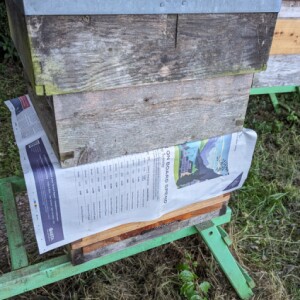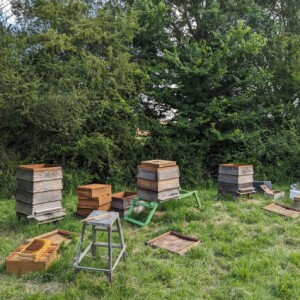There are many better pictures of insects on blip (take a bow Stevvi, Incredibish and many others), but the thing about this one is that it's mine, all mine!! It also took a very arduous hour in the hammock to capture, so it comes with a sense of achievement in the face of hardship. These hoverfly seen to have a strong sense of when they are being looked at, and an ability to accelerate that would leave a Ferrari looking red, so I have several pictures of a sky where a fly used to be, but you only have to be lucky once
We had a long, hot, sweaty morning in the apiary today, doing a lot of lifting and carrying and rearranging, as well as actually inspecting the colonies. This is a time of year when there are a lot of decisions to be made, and a lot of factors to balance up to decide what to do. How to do our best to get a second honey crop. Which queens we want to take into the winter, and how to ensure they are in strong colonies before autumn. Managing disease risk. Making sure that still expanding colonies have enough space. Matching colonies in different situations with the right hive
It's all been swirling round in my head for the past few days, and we started with a plan but, inevitably, things you see when you get there mean the plan has to be flexible. At one point we had four different hives disassembled, with hive parts cast hither and thither, pending final judgement about what to put where. I don't remember ever having had quite this level of managed chaos before. Perhaps it means I've gained a certain level of confidence that I can keep the plates spinning for a while and end the show without breaking anything. The bees just shrugged their shoulders and got on with it
Tonight, we have done a little twilight beekeeping as well - our homage to the turning of the sun, perhaps. Beekeeping attracts contrarians, so there are very few management operations where there is universal agreement about the best technique. The exception is the process of combining two colonies into one, where almost everyone uses the 'newspaper technique'. The first essential is that there should be only one queen - if both colonies have a queen present, they will fight, kill a lot of bees, and quite possibly both queens. Even having ensured a single queen, there is some risk of aggression if the two lots of bees are just suddenly placed together and left to get on with it
By far the most usual solution is to put a sheet of newspaper over the top of the box containing one colony, then put the other colony on top of it. The bees then have to chew their way through the paper before coming antenna to antenna. Something about this combined endeavour distracts them from using their mandibles on one another, and order and harmony is almost always the result
Possibly a rare instance where a newspaper contributes to the resolution of conflict



Comments
Sign in or get an account to comment.


